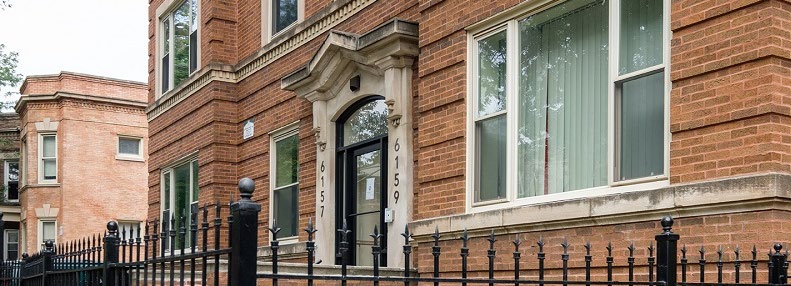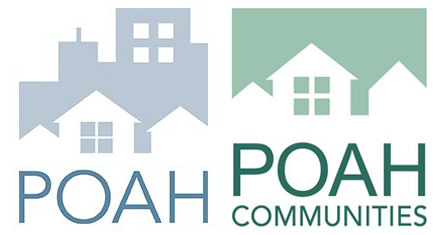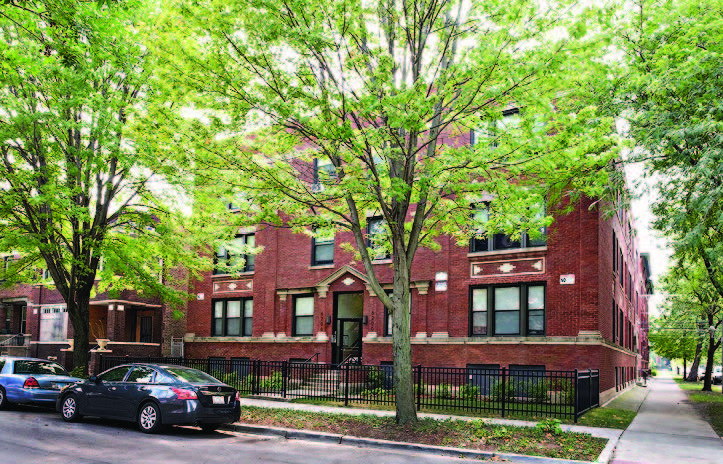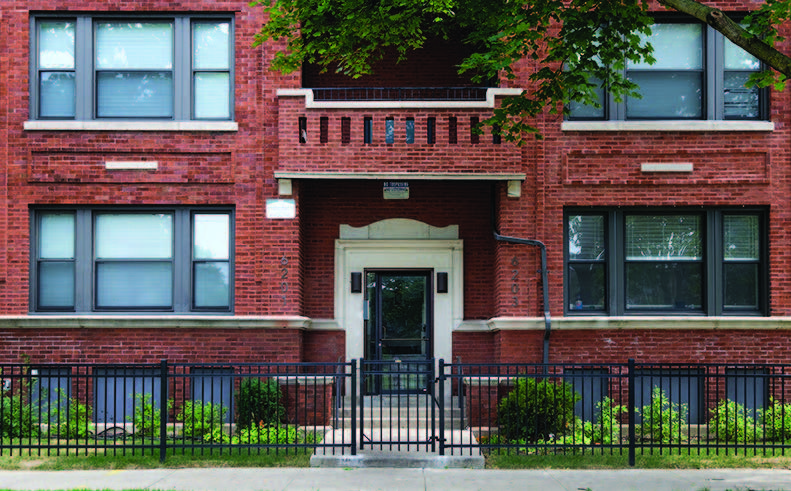The Washington at Woodlawn Park


Woodlawn Park
- Sixteen vintage apartment buildings with 196 units in the Woodlawn and Washington Park neighborhoods of Chicago
- Acquired and renovated 2010-2013
Keys to Success
Portfolio approach – Pursuing the preservation of 16 small- and medium-scale multifamily (SMMF) buildings as a portfolio required a more significant capital investment than smaller projects. But it also increased the project’s eligibility for financing, making it feasible to preserve deteriorating buildings. Preservation of Affordable Housing (POAH), a national nonprofit, addressed some financing gaps by bundling buildings into one project, since some of the properties within the portfolio were eligible for more financing and incentives (e.g., tax abatements) than others. The portfolio approach achieved economies of scale, from rehabilitation to property management. And this approach achieved more visible impact, since the properties were clustered along one corridor in Chicago’s Woodlawn neighborhood.
Neighborhood familiarity – POAH built trust with Woodlawn residents and local elected officials through past work in the neighborhood. These relationships made the process to preserve the SMMF buildings faster and more efficient. POAH’s familiarity with Woodlawn also improved their refinancing strategy. Namely, they were able to make stronger assumptions about their financing needs (e.g., knowing how many eligible households live in the market area).
Alignment with local priorities – This project aligned with existing local priorities—sustainable development and revitalization of Woodlawn. This alignment helped garner additional financial and political support and provided opportunities to leverage partners’ related initiatives.
Innovative approach to property management – Due to the size of their organization, POAH has in-house property management services, which enables them to test innovative management practices and more efficiently allocate staff resources. These practices include having a dedicated staff person to foster a sense of community across scattered sites, conducting peer exchanges to identify best practices from other similar property management organizations, and aligning property management practices and funding around targeted resident and property outcomes.
Strategy & Deal Structure
The Washington at Woodlawn Park consists of sixteen vintage apartment buildings with 196 units in the Woodlawn and Washington Park neighborhoods of Chicago. From 2010-2013, in the aftermath of the real estate crash, POAH worked with the City of Chicago and Mercy Portfolio Services to invest HUD Neighborhood Stabilization Funds in the acquisition and renovation of eleven walk-up buildings that were vacant and in disrepair. The Community Investment Corporation provided construction and permanent financing and POAH worked with Elevate Energy to install solar thermal panels and other energy efficiency measures in the buildings. POAH acquired another five troubled buildings throughout the neighborhood in the subsequent years, and refinanced the 16-building portfolio in 2017 to streamline financing costs, secure long term project-based rental assistance, capitalize additional repairs, and invest in the quality of life and curb appeal at the buildings.
The apartments at the Washington have either project- based rental assistance or serve renters up to 60 or 120% of AMI. The Washington is part of POAH’s long-term investment in the Woodlawn neighborhood as part of the Choice Neighborhoods Initiative.
|
4% LIHTC EQUITY |
||
|---|---|---|
|
Public/Private: City of Chicago Award, Syndicated by NAHT, Investor Goldman Sachs |
$ 5,850,043.00 |
Tax credit pricing = $0.95 |
|
FIRST MORTGAGE/TAX EXEMPT BONDS |
||
|
Public Private: City of Chicago-issued bonds, Citibank construction and permanent debt |
$ 10,900,000.00 |
35 years, 4.61% |
|
Public: City of Chicago, New NSP Loan |
$ 1,738,877.00 |
32 years, 4.75% |
|
SELLER EQUITY (Acquisition note , reserves, cash flow from operations) |
||
|
Non-profit: Preservation of Affordable Housing |
$ 5,915,208.00 |
32 years, 5% |
A new LIHTC Partnership acquired the 16 buildings, but in a unique arrangement, did not assume the $13.3 M in NSP debt and $1.2 M from Choice Neighborhoods program from the original acquisition and renovations of the projects, because of the impact it would have on tax losses for the new investor. The seller of the properties, a POAH-owned entity, will continue to hold the debt and be subject to the compliance requirements. However the Partnership as new owner, is responsible for compliance and indemnifies the seller entities for any defaults or non-compliance.
Because POAH was also the buyer and seller of the property – we could sell it to ourselves for the price of debt payoff, allow the majority of equity and proceeds to be used for rehab and then take an acquisition “seller note” for the appraised value of the property. This allows the investor to take more acquisition credits and gives POAH incentive for cash flow from operations in the waterfall to pay down the note, should there be any net cash in future years.
Developer



Preservation of Affordable Housing (POAH) is a national nonprofit organization whose mission is to preserve, create and sustain affordable, healthy homes that support economic security and access to opportunity for all. Since 2001, the POAH team has advanced its mission with a blend of expertise and creativity, solving complex problems that others have seen as insurmountable. We have secured long- term affordability for residents while addressing the interests of owners, funders, public agencies, and other stakeholders. The result is the preservation of close to 11,000 affordable rental apartments through transactions that guarantee that rents will remain affordable for the long-term (30+ years).
We are active in 11 states and the District of Columbia, in the Northeast, mid-Atlantic, Great Lakes regions and the state of Florida. All of POAH’s properties are managed by POAH Communities, POAH’s subsidiary property management company. In 2008, POAH partnered with the City of Chicago and a wide array of public and private community partners to purchase and redevelop the former Grove Parc Plaza, a Section 8 development with 504 units in the in the Woodlawn neighborhood on the South Side of Chicago. The property faced financial collapse and physical deterioration. The neighborhood itself had experienced disinvestment challenges for decades.
POAH leveraged a $30.5 million HUD Choice Neighborhoods grant to drive the redevelopment of Grove Parc property and new investments in housing for all income levels. In addition, POAH invested in social services and job training programs, new commercial activity, and other neighborhood improvements. POAH replaced about half of the 504 units on the 12 acre site formerly occupied by the Grove Parc buildings and renovated 22 other buildings throughout the neighborhood to replace the other units. The 16 buildings, containing 121 Section 8 units at the Washington represent a significant number of the replacement units for the former Grove Parc, and are situated in healthy mixed-income configurations throughout the neighborhood in newly renovated buildings. At the same time it was working on preserving valuable rental housing in the neighborhood, POAH worked with partners to create the Renew Woodlawn homeownership program - to identify prospective home buyers and provide them with funds for renovations and a discounted purchase price to purchase existing, architecturally significant neighborhood homes.
POAH’s multi-year, multi-phased redevelopment has created a revitalized, vibrant community and today Woodlawn is one of only a few South Side communities where housing sales are rebounding, economic development is growing and residents feel safer and more hopeful.
Neighborhood
-
Cap rate – the income capitalization for the appraisal that POAH used for the transaction used a 7.5% cap rate.
-
Absorption rate – the City of Chicago waived the need for a market study for the project because of the existing occupied units. For similar projects that POAH has completed in the neighborhood with 1, 2 and 3 bedroom units, previous market studies have calculated the number of eligible households in the market area to be 18,000.
Special Features
-
11 of the 16 properties take advantage of the Cook County’s tax abatement program, Class 9 (and the other five are not eligible because they didn’t meet minimum rehab or minimum unit tests).
-
POAH had to meet the City of Chicago’s Sustainable Development guidelines for the moderately renovated buildings, including 80% waste diversion and committed to 20% water savings anticipated from all new efficient plumbing fixtures. The earlier renovation of seven of the buildings included solar thermal hot water system as part of those earlier NSP-funded renovations.
-
As noted above, the project is a result of a strong partnership with the City of Chicago and POAH to work on the overall revitalization of the Woodlawn neighborhood.
-
The renovation of the Washington properties happened alongside the Renew Woodlawn program on many of the same blocks. For that program, POAH worked with two Chicago-based housing non-profits (Neighborhood Housing Services and the Community Investment Corporation) to increase homeownership, with a dual focus on renovation of vacant or troubled buildings and low-interest loans and homeowner training, as well as a commitment to community engagement for block improvements and safety. Over its first three years, Renew Woodlawn created 43 new homeowners and in the process has reinvigorated the market for moderately-priced homeownership in a part of Woodlawn that for several years saw only distressed sales of 1-4-unit properties.
-
In addition, the property has a unique pay-for-results social services structure to provide a stream of funding aimed at demonstrating the beneficial impact of ongoing resident services for residents and property outcomes. The syndicator National Affordable Housing Trust and investor Goldman Sachs are both financial parties in the pilot Strong Families Fund (SFF) program. This Program allows experienced affordable housing developers to divert half of the Partnership’s operating reserve to seed social services in the first three years of the project (here 3 months of operating expenses and debt service, just over $600k) and allows for payments of up to $90k per year in subsequent years based on reporting and meeting outcomes measures. The Kresge Foundation guarantees the operating deficit funds pledged to social services should they be needed. In addition, the Corporation for Supportive Housing provides training and support and peer learning opportunities for the several projects in the pilot group. The SFF Program has allowed the property to hire a full-time Community Impact Manager who connects residents to community resources, plans community engagement activities and helps mitigate property manager’s challenges with non-payment, public safety or housekeeping issues. In a scattered site project that lacks a cohesive sense of community, and where management doesn’t interface with tenants on a weekly or even a daily basis, having dedicated Community Impact staff helps build community and strengthen outcomes for residents.
Impact
There are many layers to the preservation with this project.
 Preservation of Affordability: First of all, the Washington provided off-site replacement apartments in the neighborhood for 121 of the 504 deeply affordable Section 8 unit subsidies that had been located at the former Grove Parc Plaza complex, which was physically obsolete and threatened with condemnation and foreclosure. In addition to these units, almost two hundred apartments have been built on the former site, with a total of 430 of the original 504 units remaining in Woodlawn, though renovation and new construction. In an effort to preserve units while deconcentrating poverty, POAH and partners were able to retain the Section 8 subsidies that had been at Grove Parc by dispersing that assistance. POAH was able to keep the affordability in the neighborhood, ensuring longtime residents and new low-income families would be able to take advantage of the neighborhood as it improved. Indeed, the neighborhood has improved, with a new full service grocery store opening a few blocks from many of the buildings at the Washington, a new daycare center, recreational center and restaurants and other businesses, including a bakery and a yoga studio. Instead of the affordability being conspicuously clustered in three superblocks at the center of the neighborhood, the units are now housed in renovated historic neighborhood buildings that are indistinguishable from other market assets. In a fairly innovative structure, the Housing Assistance Payment (HAP) contract was split between multiple phases and partnership and extended for another 20 years. These apartments are still deeply affordable, targeted to residents making an average of 50% AMI.
Preservation of Affordability: First of all, the Washington provided off-site replacement apartments in the neighborhood for 121 of the 504 deeply affordable Section 8 unit subsidies that had been located at the former Grove Parc Plaza complex, which was physically obsolete and threatened with condemnation and foreclosure. In addition to these units, almost two hundred apartments have been built on the former site, with a total of 430 of the original 504 units remaining in Woodlawn, though renovation and new construction. In an effort to preserve units while deconcentrating poverty, POAH and partners were able to retain the Section 8 subsidies that had been at Grove Parc by dispersing that assistance. POAH was able to keep the affordability in the neighborhood, ensuring longtime residents and new low-income families would be able to take advantage of the neighborhood as it improved. Indeed, the neighborhood has improved, with a new full service grocery store opening a few blocks from many of the buildings at the Washington, a new daycare center, recreational center and restaurants and other businesses, including a bakery and a yoga studio. Instead of the affordability being conspicuously clustered in three superblocks at the center of the neighborhood, the units are now housed in renovated historic neighborhood buildings that are indistinguishable from other market assets. In a fairly innovative structure, the Housing Assistance Payment (HAP) contract was split between multiple phases and partnership and extended for another 20 years. These apartments are still deeply affordable, targeted to residents making an average of 50% AMI.
Preservation of Historic Housing Stock: In addition, sixteen historic buildings in the neighborhood were are risk of not being preserved. All were purchased as distressed includes eight of these POAH-developed buildings and the impact on the corridor is significant.
Mixed-Income Community: The apartments will also carry long-term affordability restrictions. Three-quarters of the 196 units are encumbered with Low Income Housing Tax Credit restrictions, which were extended for fifty years from the date of refinancing. In addition, while the earlier NSP financing to complete the first set of acquisition/rehabs had been set to expire after 15 years, this second refinancing allowed the City to keep the overall 120% income restrictions for the remaining 51 units in place for another 30 years, to be coterminous with the tax exempt bond loan. Because the projects are scattered site (though some are adjacent) and mixed- income, they are broken up into four LIHTC allocations, which allowed POAH to continue to deliver mixed income 120% units for HUD Choice obligations. In the future, POAH may be able to cross subsidize the affordable units if rents rise on these properties, or may use income averaging to make them a part of a future LIHTC transaction.
Positive Resident Impact: This project positively impacts 196 households and nine separate blocks in the Woodlawn and Washington Park neighborhood. As a result of our Choice Neighborhoods family support work and the Strong Families Fund, we are able to further innovate to bring HUD’s Family Self Sufficiency (FSS) program to the 121 Section 8 units at this property in the future, allowing tenants to bank and save their rent increases that result from each household’s increased income. This program has been implemented at other POAH properties in Woodlawn and will be in place at the Washington within a couple of years. POAH is one of the first non-Public Housing Authority private non-profit owners to use the FSS program and its pilot programs have shown earnings’ increases by 60% of the participants, allowing families to start to put aside resources that build wealth. We look forward to these same results for the Washington families.